Gretz Car Series, 1958
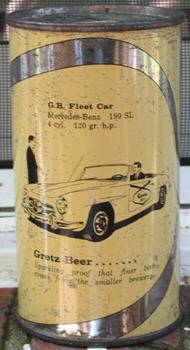 |
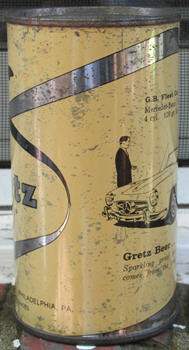 |
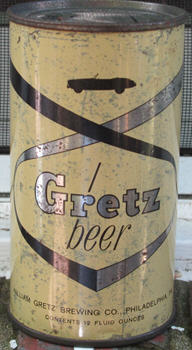 |
(photos updated with a nicer can, October 2013)
The Gretz car series was issued starting in late 1957 by the Gretz Brewing Company in Philadelphia. The smallest of the last four breweries in Philadelphia, Gretz decided to make its small size a selling point by comparing its beer to a sports car. Small cars were better, they argued, and so was a beer from a small brewery! As part of the promotion Gretz bought 11 of the latest sport cars and painted them yellow and black to match the Gretz label colors, with a Gretz logo on the sides. The cars were introduced at the Army-Navy Game in Philadelphia at the end of November 1957 (Navy won 14-0).
The 11 cars featured in the set include:
Alfa Romeo
Austin Healy
Corvette
Fiat 600
Fiat 1100
Isetta BMW
Mercedes Benz
MGA Convertible
MGA hardtop
Porsche 1500
Saab 93
There is also a 12th can in the set, a Ford Thunderbird. However, the articles published about this promotion at the time do not list the Ford as one of the cars purchased by the brewery. That raises some interesting questions. The cans probably would have been designed and ordered well before the promotion started. Did Gretz plan on buying a Thunderbird? Did they change their mind? Did something happen to the order at the last minute? Was it a budget decision, to cut back on the expense of buying another car?
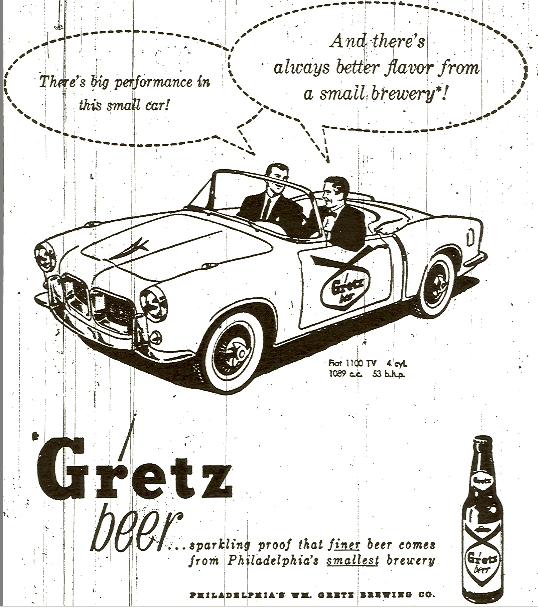 |
Gretz newspaper ad from January 1958 and a photo of the 11 Gretz cars together. | 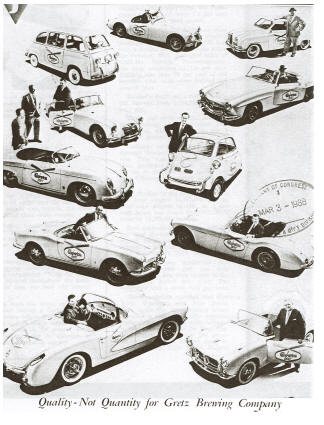 |
I don't know yet how long the promotion lasted, but it could not have been too long, as the brewery closed in 1960. As of 2005, the building was still standing. While this promotional campaign lasted the brewery took out ads in local papers featuring the various cars. (see above)
William Gretz Brewing 1933-1960
William Gretz started off with a brewery on North 4th Street in Philadelphia which he ran from 1880-1884. That business apparently did not last long, as it disappears from the records in 1884. However, in 1881 William Gretz had also become a partner in a brewery owner by Leonard and Frank Rieger. The Rieger& Gretz Brewing Company stayed in business at Germantown and Oxford Streets until 1920, when closed by Prohibition.
In 1933 the brewery reopened as the William Gretz Brewing Company. They adopted cans fairly early and canned their beer in a j-spout. It's a rare can, especially as j-spouts were replaced in 1940 by crowntainers. But the Gretz crowntainer is a rare can as well.
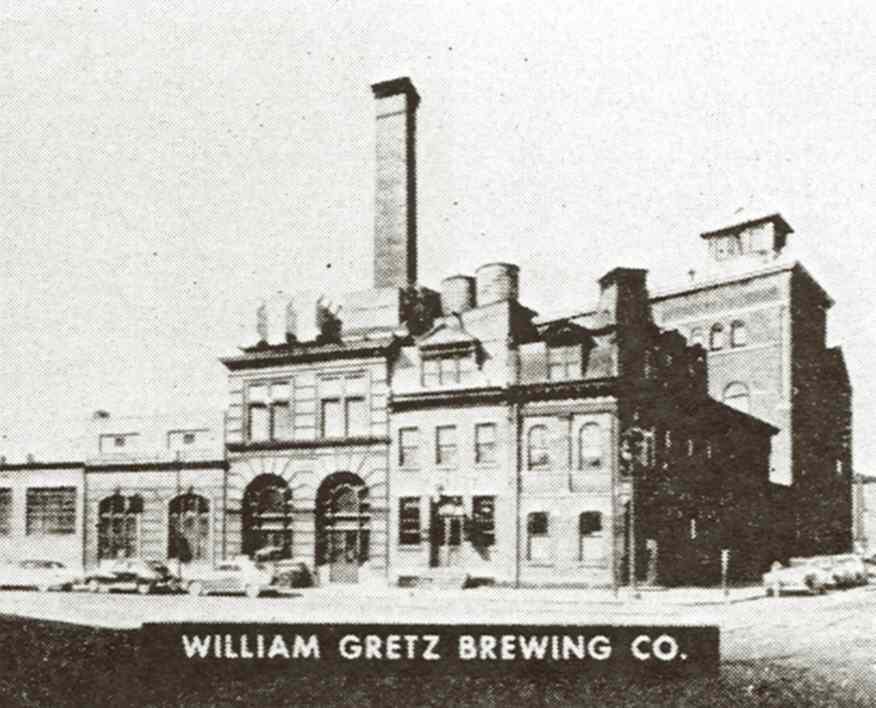 |
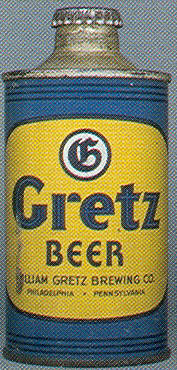 |
| The Gretz Brewery, circa 1949. | The Gretz J-spout. |
| In 1940 Gretz constructed a large billboard in Philadelphia with nothing but a large Question Mark and the text "Made the Old Fashioned Way." After three weeks the ? was replaced by a moving billboard with the man on a "high wheel" bicycle (invented in about 1870, they were especially popular in the 1880s. www.pedalinghistory.com) The man on the bike moved his legs, peddling the bike. It ran from 7 am until 1 am. The billboard seemed to have been a hit. People began asking the brewery how fast the man on the bike was moving (15 miles an hour). The man on the big wheel bike was a standard part of Gretz's advertising until the closed in 1960. |
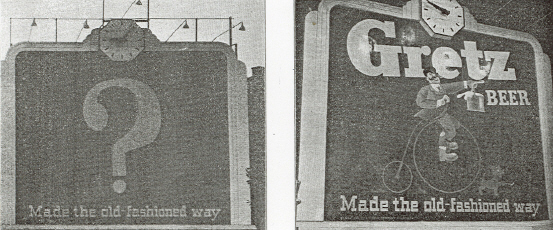 |
After World War II Gretz switched to high profile conetops, and then to flat top cans. They are all hard to find to varying degrees, ranging from rare to "fairly tough," or on the Dumper's Guide to Rareness, from about a 6 to a 9. It was also about 1940 (as far as I can tell) that Gretz started their "man on a bicycle" theme that they used on their labels and in their advertising. It showed a man on an old-fashioned bicycle, the kind with one large wheel and one small.
In 1951 they became the first Philadelphia brewery to use television as advertising (according to a 1951 news story). Titled "The Gretz Cavalcade of Girls" the hour-long show aired on WFIL-TV Thursdays at 11:30 pm. The show followed a variety format with variety acts and music (Henny Youngman appeared on the first show) and after six weeks the audience could mail in postcards to vote for their favorite "Gretz Golden Girl." The winner was a Miss Joan Kinckiner of Camden, who topped 35 other girls. First prize was a TV contract to act as the pro
In 1956-1957 Gretz marketed the "Tooner Schooner" set, a colorful set of can with "Gay 90s" illustrations and lyrics to an old standard song printed on the sides. The cans are hard to find in good shape, and in mint condition usually sell in the hundreds of dollars. According to United States Beer Cans there are 21 different cans featuring the lyrics to 20 different songs:
A Bird in the Hand
After the Ball
Casey Jones
Everybody Works but Father
Hello Ma Baby
I Want a Girl, Just Like the Girl
I Wonder Who's Kissing Her Now
Ida Sweet
In the Good Old Summertime
Kentucky Babe
Let me Call You Sweetheart
Meet Me Tonight
My Gal Sal
My Wild Irish Rose
Sweet Rosie
Take Me Out to the Ball Game (2 color variations)
The Sidewalks of New York
Wait till the Sun Shines Nellie
When You Were
Just where they got the idea for this set is an interesting question. "Tooner Schooner" was the name of a popular humorous novel written by Mary Lasswell published in 1953. She also wrote "Suds in Your Eye" (1942) and other novels featuring three elderly ladies who have adventures together, and who enjoy their beer. When "Suds in Your Eye" was made into a play, the sets were often made of beer cans. Did the book inspire the can set?
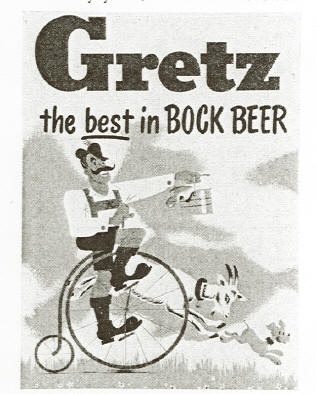 |
| 1951 Gretz Bock Beer ad with the man on the bike. |
The smallest of Philadelphia's breweries that survived after World War II, Gretz marketed their beer mostly in eastern Pennsylvania and New Jersey, although I have dumped a handful of them in northern Virginia. In early 1958 Gretz dropped production of draft beer, and sold their product only in cans and bottles. At that point they must have had so few taverns and restaurants selling their product that this made sense as a cost cutting measure.
After closing in 1960, first Esslinger, then Jacob Ruppert breweries made Gretz beer for awhile but eventually dropped the brand. The brewery buildings still stand.
As always, I welcome corrections and additions: please email me at Mark@rustycans.com
(thanks Jeff for the heads-up!)
Name Changes
Albert Schwatrz 1861-1871
(John) Grundler & (Charles) Schwartz 1871-1872
John Grundler 1873-1876
Leonard & Frank Rieger 1881
Rieger & Gretz, Tivoli Brewery 1881-1909
Rieger & Gretz Brewing Company 1909-1920
William Gretz Brewing 1933-1960
Sources Used:
"Advertising Key Element in Gretz Sales Program" Modern Brewery Age (Feb 1948)
"A Teaser Sign That Has Done a Very Good Job" Brewers Journal (January 15, 1941)
"Small Cars Emphasize Quality - Not Quantity" Brewer’s Journal (January 1958)
"The G B Fleet" Brewer's Digest (Jan 1958)
Van Wieren, Dale P. American Breweries II. (West Point, PA., East Coast Breweriana Association, 1995)
Wagner, Rich and Rich Dochter. Guidebook to the Philadelphia Brewery Tour. 1997.
Western Brewer, 100 Years of Brewing. (Chicago: H.S. Rich & Co., 1903)
